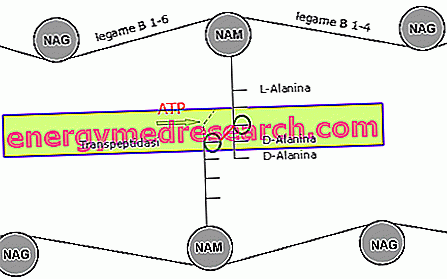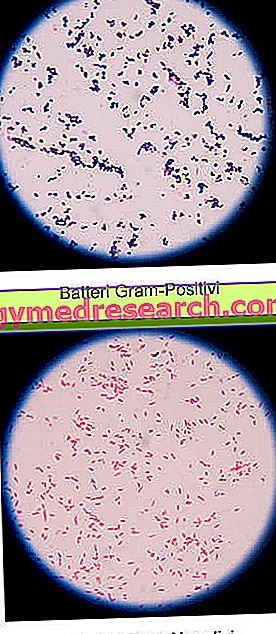Chemical composition
the priority component of the bacterial cell is water, which represents 80% of the cell mass and the solvent in which the various components are dispersed: organic (lipids, proteins, polysaccharides and nucleic acids) and inorganic (minerals such as sodium, zinc, phosphorus, iron, calcium and sulfur.).
Core
the bacterium is a prokaryotic cell and as such it is different from the eukaryotic one (typical of man, but also of plants, animals and fungi), first of all due to the absence of a nuclear membrane. Within the bacterial cell we would then have a single chromosome, immersed directly in the cytoplasm and containing DNA wrapped in a superspiralized circular structure. Usually this DNA is in close association with particular regions of the plasma membrane (MESOSOMI), where enzymes reside for bacterial replication and for energy production (oxidative phosphorylation).
Bacterial ribosomes
Inside the bacterial cells we find the ribosomes, smaller than the eukaryotic ones and with different structure and sedimentation constant [70s in the bacteria (50s greater subunit, 30s lesser) and 80s in the eukaryotes (70s greater subunit, 40s minor)]. They consist of proteins and RNA, formed from the chromosomal DNA through the transcription process.
The differences that separate bacterial ribosomes from human ribosomes (let us remember that the ribosome is the cellular organelle responsible for protein synthesis) has allowed the development of selective drugs, capable of inhibiting bacterial protein synthesis without interfering with human protein.
Plasma Membrane
The plasma membrane of the bacterium is very similar to the eukaryotic, although more subtle; first of all we can recognize the typical phospholipid double layer, in which glycoproteins and glycolipids are immersed. Also the functions are analogous, since the bacterial plasma membrane regulates the exchanges with the environment. Outside it we find a characteristic structure, the bacterial wall. It is very important to point out, in this regard, that the GRAM + bacteria possess only the plasma membrane and the cell wall, while in the GRAM - there is an additional structure, called the outer membrane.
Bacterial Wall
The Bacterial Wall provides the bacterium with rigidity and strength, preventing it from being damaged when in an environment with reduced osmotic pressure; it also performs defense functions against phagocytosis, and regulates the exchange of nutrients and metabolites with the outside world (in synergy with the plasma membrane).
The main constituent of the bacterial part is a polymer called peptidoglycan, more often in GRAM + bacteria and thin in GRAM -. The two monomers that constitute it are amino sugars, called N-acetylgucosamine (NAG) and acetyl Muranic acid (NAM), joined together by glycosidic bonds B 1-4 and B 1-6. To each molecule of N-acetyl Muranic acid are bound 5 amino acids, of which the 1st is L-alanine, while the last two are D-alanine.
Many NAG and NAM monomers therefore give rise to a peptidoglycan molecule, and more peptidoglycan molecules bind together to form the bacterial wall. This association is guaranteed by the action of an enzyme, called TRANSPEPTIDASI, which gives rise to a peptide bond between the third amino acid of a chain and the fourth of the parallel chain. The energy needed to make this union is provided by the loss of the fifth amino acid, which we recall being a D-alanine. Penicillin, a well-known antibiotic, acts at this level, preventing the link between the third and fourth amino acids of the two parallel chains. The lysozyme, a powerful antibacterial present - among other things - in saliva and tears, instead breaks the B 1-4 bond that holds the NAM and NAG monomers together.
In GRAM bacteria - the link between the third and fourth amino acids is direct, while in positive GRAMs it is mediated by 5 wisteria (pentaglycine bridge).

As important as it is, the cell wall is not an indispensable structure for the life of the cell, so much so that some bacteria do not. Inside it there can also be molecules called TEICOIC ACIDS, typical of positive GRAM bacteria, but also present in GRAM -; these are polymers of polyvalent alcohols (glycerol), associated with amino acids and sugars, which are intended to hinder the degradation of peptidoglycan by lysozyme and other bactericidal agents.
External membrane
Typical and exclusive to GRAMs - it is associated with the bacterial wall using lipoproteins. It consists of two sheets, of which:
- the innermost is of phospholipid nature;
- while the exterior consists of a repeated liposaccharide molecule, the so-called LPS (or lipopolysaccharide).
The LPS lipopolysaccharide is in turn divided into three layers:
- the innermost one, of lipidic nature, is called LIPIDE A; it is the same for all GRAM bacteria - and constitutes its toxic component (ENDOTOSSIN); many of the classic clinical symptoms of a GRAM infection are therefore ascribable to lipid A, among which fever is undoubtedly the most common disorder.
- The central part, of polysaccharide nature, is called C (or core) and is the same for all bacteria.
- The external part is called ANTIGENE O, it is always polysaccharidic, but it is different from bacterium to bacterium.
The outer membrane also recognizes very small proteins, called porins, which regulate the intake of nutrients, but also of other substances, such as the antibiotics themselves (they oppose their entry).
COMPARED TO THE EUKARYOTIC CELL: in addition to the differences already listed, the bacterial cells lack some complex eukaryotic structures (endoplasmic reticulum, mitochondria, Golgi apparatus, chloroplasts, centrioles and mitotic spindle).



